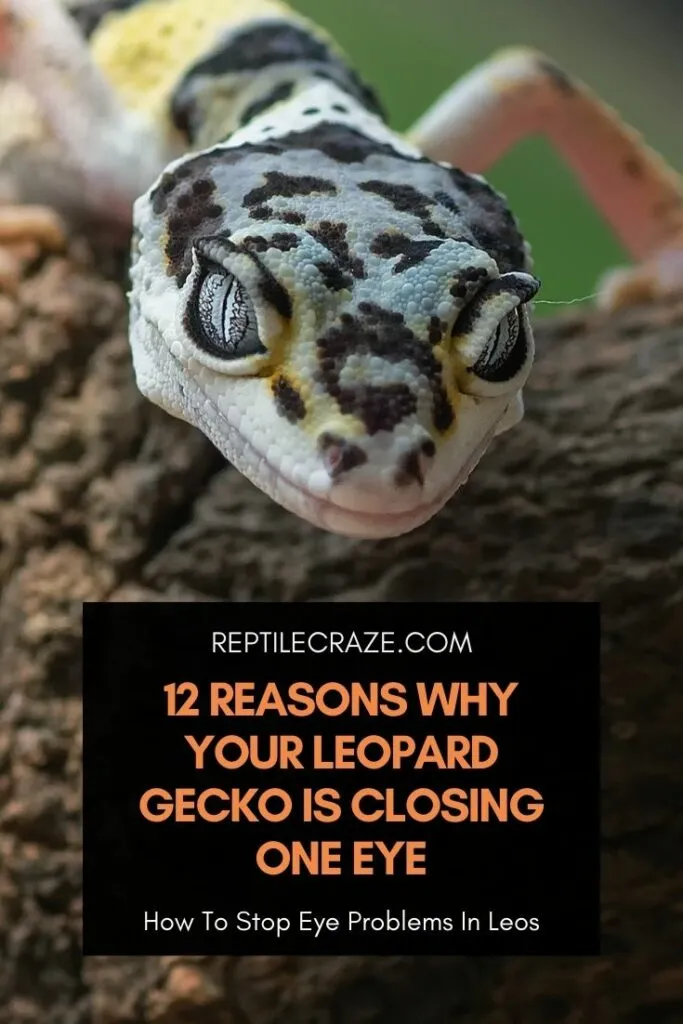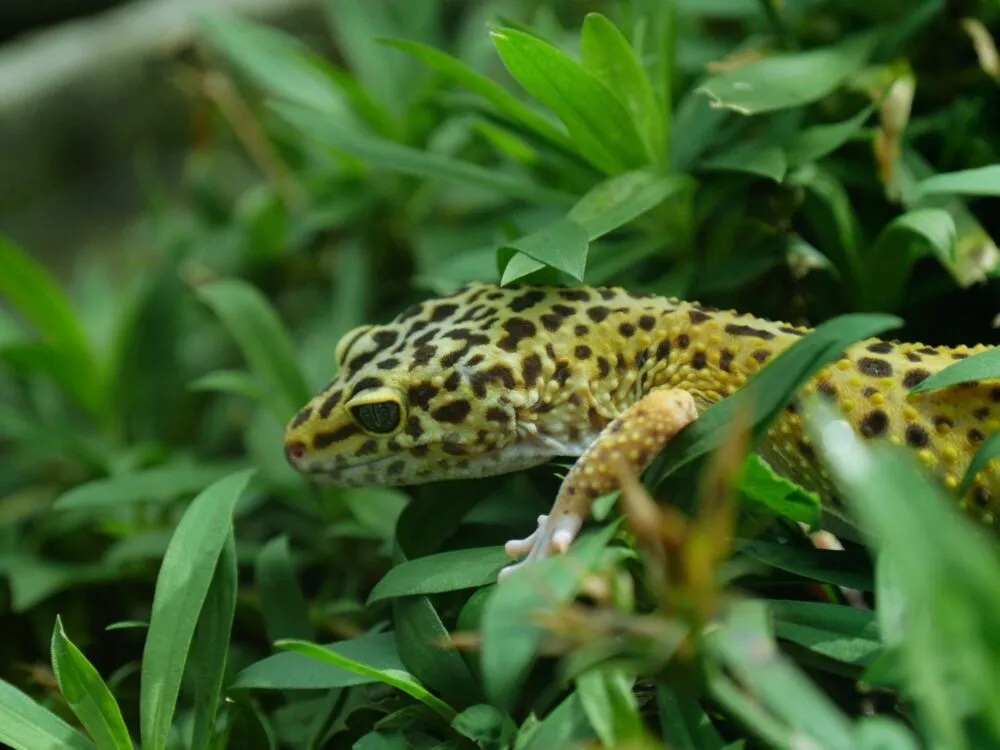
Even after all these years, my leopard geckos still surprise me. For example, one of my male leopard geckos, Ralf, started closing one eye for prolonged periods last year and it sent me down a rabbit hole trying to figure out what was wrong. If you’re wondering why your leopard gecko closes one eye, here’s the answer.
Leopard geckos close only one eye when their eye is irritated. This can be from debris underneath the eyelid or a stuck scale during shedding. It can also be caused by infection, malnutrition, and low humidity. However, sometimes having one eye open is healthy behavior, such as during sleep.
There are several things you can do to solve abnormal eye-opening as I did with Ralf. Read on to discover why this happens and what you can do about it to keep your leopard gecko healthy.
Table of Contents
Why Your Leopard Gecko Closes One Eye
First of all, don’t be too alarmed if your leopard gecko is closing one eye every now and then. No, he or she is not winking at you, but you should only have concerns if one eye is closed for extended periods.
If your leopard gecko is closing its eye for prolonged periods and you’re worried about it, you’ll want to identify the underlying issue so you can help your little lizard buddy. Remember, the eye is one of the most fragile areas on a leopard gecko’s body, so be very careful with your pet.
Here are some of the most common problems that can lead to your leopard gecko closing one eye.
1. Trauma
Even in the safety of your
Be especially wary if you are housing another leopard gecko in the same
If your leopard gecko appears to have an injury, take it to a vet asap. If you don’t live near an exotic vet, book an online vet at Vetster here. They offer 24/7 appointments and have great, affordable service.
2. Retained Skin
You’ll want to make sure that your pet has healthy shedding for a leopard gecko. Unlike many other lizards, leopard geckos have eyelids, so they shed skin both on the lids and the surrounding area.
If there is some retained or stuck skin near the eye, it can stop your leopard gecko from being able to open its eye without irritation.
If the skin under the eyelid has shed and stuck there, it can seriously damage the cornea of the eye over time. Correcting this requires an expert.
To prevent shedding problems in leopard geckos, you should put a moist hide into your leopard gecko enclosure. For that, use this cave here and fill it with a bit of sphagnum moss (like this one) as substrate. Mist the moss whenever it is dry.
This way the humidity in that cave will be quite high, which helps with shedding.
3. Debris
I’ve had dust stuck in my eye, and it’s the worst! Leopard geckos climb around a lot more and their eyes are closer to the ground, so it’s a lot more common for them than it is for us.
Sand, grit, and even larger pieces of material can become lodged under the eyelid. Usually, the leopard gecko will get rid of this by blinking and secreting fluid around the eye, but sometimes that doesn’t work. If you see any bulges under the eyelid when closed, this could be the issue.
4. Dry Eyes
Leopard geckos secrete a fluid from their eyes to keep them hydrated and clear of debris. If your leopard gecko isn’t getting enough water or the humidity in your
Again, providing a moist hide as we explained above can help here.
5. Infection
Leopard geckos can experience three types of eye infections. These are:
- Viral
- Fungal
- Bacterial
Any of these three can penetrate the eye, especially if the cornea or pupil is scratched. This can result in significant damage, even altering the size of the eyeball through inflammation or mass shrinkage.
Bacteria such as pseudomonas and fungi such as Acremonium sp. have been found in leopard gecko eyes, requiring antibiotic and antifungal treatments, respectively.
Conjunctivitis is the most common form of eye infection and causes a red, weeping eye. This is easily treated with antibiotic drips.

6. Vitamin A Deficiency
Also known as hypovitaminosis A, vitamin A deficiency has been linked to several eye conditions in leopard geckos. This often presents itself as very similar to conjunctivitis.
In fact, it can be so similar that there has to be a biopsy of tissue in order to know for sure. Many good vets will treat for both vitamin A deficiency and conjunctivitis at the same time just to be on the safe side.
Gut loading (feeding) feeder insects like crickets with this food (check it out here) will help with preventing and correcting vitamin deficiencies in your leopard gecko. We highly recommend it!
7. Abscess
One common cause of unusual eye closing in leopard geckos is when a subcutaneous abscess forms. This looks like a small bump under the skin, usually beneath the eye. Abscesses are usually started because of an infection or trauma.
8. Parasites
Eye parasites aren’t too common in leopard geckos when in captivity. This is because they tend to be in isolation from larger populations. However, occasionally this can happen.
If this is the case, worm parasites can be seen swimming around inside the eyeball. Yes, you have my permission to say “yuck!”.
9. Congenital Issues
Unfortunately, some eye closing issues are congenital due to abnormalities brought about by faulty genes. These will usually be obvious early on in your pet’s development.
In extreme cases, this will be the result of anophthalmos where the eye hasn’t formed at all. However, when it comes to eye closing, the abnormality is most likely to be found in the eyelid itself.
Ankyloblepharon happens when the eyelids are fused together, but this usually can be fixed with a surgical procedure.
10. Neoplasia
Neoplasia is a form of lesion or growth that’s caused by the uncontrolled growth of cells. This can be cancerous, but it can also be benign. This would need to be identified with a biopsy of any unusual lumps. Most of the time, these will only be abscesses.
11. Light
If you don’t provide the correct light setup for your leopard gecko, your pet might develop eye problems, including closing one eye. With too much light and nowhere to shade or hide, your leopard gecko will get seriously ill.
If the light is shining off of a reflective material, your leopard gecko will close one eye to protect itself from too much illumination. Make sure to keep anything reflective away from the outside of your
Studies have shown that leopard geckos do better with UVB bulbs in their enclosure. If you are using, or if you plan to use UVB bulbs in your leopard gecko
12. Leopard Gecko Sleeping With One Eye Closed
Before we discuss treating single eye closing in leopard geckos, I wanted to give a quick word about leopard geckos when they sleep.
It’s normal for a leopard gecko to keep one eye open at times during sleep.
These amazing animals have evolved to avoid predators even when sleeping. Part of their brain remains active, allowing them to open an eye if they hear or feel something nearby.
This acts as an early warning system. So, if you’re messing around with your
Dolphins, whales, and birds have been shown to have unihemispheric slow-wave sleep. This means that they keep one side of their brain awake with one eye open.
Some lizards are thought to do this, too. It’s possible that leopard geckos are doing this to keep one eye open, but more research is needed to prove this theory.

How to Treat Abnormal Eye Opening in Leopard Geckos
Your leopard gecko’s eye is very delicate and so some problems must be rectified by your vet, including:
- Infection
- Conjunctivitis
- Serious trauma
- Retained skin
- Parasites
- Neoplasia
- Congenital issues
- Vitamin A deficiency
It can be tempting to try to avoid veterinary bills and try to do some DIY pet fixing. But hey! Your pet isn’t a tree that needs cut down or a wall you’re thinking of knocking through… Actually, you should probably get an expert in for those, too!
If you have any doubts about what is going on with your leopard gecko’s eye, speak to an expert. The golden rule is:
If the eye is permanently closed, do not open it!
You can do permanent, even life-threatening, damage to your pet.
All that being said, there are still some common issues you can fix yourself, at least some of the time.
Debris
We still highly recommend consulting a vet first, but if your leopard gecko does have something in its eye other than a stuck shed, you could try gently rinsing out its eye with a saline eye rinse.
We recommend this Reptile Eye Rinse (check here) for that.
If you want to use another product, make sure it’s one that’s preservative-free and safe for reptiles! Never try to pick something out of the animal’s eye, as you could blind it.
Light Issues
Ensure that your leopard gecko has both the correct lighting and the correct environment. A UVB light up to 5% (like this one here) is advisable, lit for 12 hours during the summer season and for 10 hours during winter.
Make sure you have some shade for your leopard gecko and line any hides with a moist substrate like this sphagnum moss.
Dry Eye
Mist your
Other than many other hygrometers, this hygrometer is very accurate and reliable.
Make sure you keep an accessible clean pool of water for bathing and drinking.
How to Stop Eye Problems in Leopard Geckos
While you are treating your leopard gecko’s abnormal eye closing, you can take steps to stop it from happening again. Some tips for this include:
- Keeping your
tank clean to minimize debris and grit. - Using a soft substrate like sterile soil that won’t blind your pet if it gets in its eyes.
- Make sure any rocks have smooth edges.
- Provide the correct diet for a leopard gecko such as fresh crickets and mealworms. Dust any dried foods with a vitamin supplement.
- Isolate any aggressive gecko.
Conclusion
I hope this has answered why your leopard gecko is closing one eye. Any unusual behavior can be concerning as a leopard gecko owner. But with a little patience and know-how, you can identify these issues quickly and get your little lizard buddy back to his or her best.
If you need help with that, we recommend bringing your leopard gecko to a vet or booking an online vet at Vetster here!
- Enchi Ball Python: A Unique and Stunning Morph of Python regius - March 27, 2025
- Emerald Tree Monitor: The Enigmatic Green Guardian of the Rainforest - March 26, 2025
- The Egyptian Cobra (Naja haje): A Fascinating Serpent - March 25, 2025
